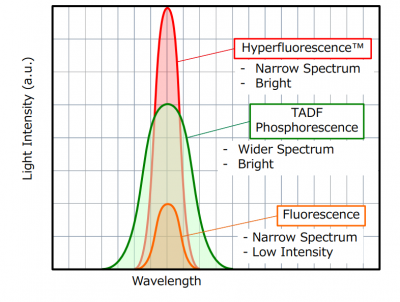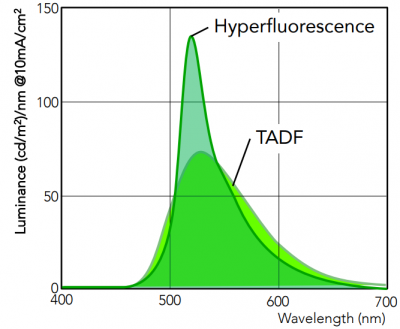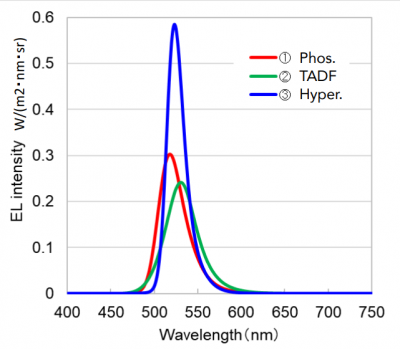The narrow spectrum of Hyperfluorescence™ enables better efficiencies than both TADF and PHOLEDs
The first-generation OLED emitter systems, based on fluorescence, lack efficiency as only about 25% of the energy is converted into light. More advanced systems, based on phosphorescence (PHOLED), TADF and our own Hyperfluorescence™ (HF) technology all manage to convert almost 100% of the energy into light, and so it is mistakenly perceived that such systems all offer the same efficiency.
 The reality, however, is that Kyulux’s HF systems offer an inherent advantage that enables it to provide the most efficient OLED emitters of all four generations. As seen in the graph above, HF emitters are the only emitters that offer both a narrow spectrum and high-efficiency. HF can be thought of as a combination of the high efficiency of TADF and the narrow spectrum of Fluorescence.
The reality, however, is that Kyulux’s HF systems offer an inherent advantage that enables it to provide the most efficient OLED emitters of all four generations. As seen in the graph above, HF emitters are the only emitters that offer both a narrow spectrum and high-efficiency. HF can be thought of as a combination of the high efficiency of TADF and the narrow spectrum of Fluorescence.
 Looking at the “number of released photons” (or Internal Quantum Efficiency, IQE), we see that TADF, PHOLEDs and HF all output about the same number of photons. In the graph above you can see a good comparison of HF and TADF. The integrated area of these graphs are the same – but the emission in HF is much narrower. This narrow spectrum can enable displays with a wider color gamut, which is obviously terrific. The narrow spectrum also means that to reach the same brightness you can use a lower current – which directly leads to a more efficient device.
In fact, driving the OLED at a lower current is not only good for power consumption (as OLEDs are more efficient at lower currents) – it also prolongs the lifetime of the sensitive OLED materials.
Looking at the “number of released photons” (or Internal Quantum Efficiency, IQE), we see that TADF, PHOLEDs and HF all output about the same number of photons. In the graph above you can see a good comparison of HF and TADF. The integrated area of these graphs are the same – but the emission in HF is much narrower. This narrow spectrum can enable displays with a wider color gamut, which is obviously terrific. The narrow spectrum also means that to reach the same brightness you can use a lower current – which directly leads to a more efficient device.
In fact, driving the OLED at a lower current is not only good for power consumption (as OLEDs are more efficient at lower currents) – it also prolongs the lifetime of the sensitive OLED materials.
 The graph above, which uses data from optical simulation, shows a nice comparison of the three OLED emission technologies. Compared to PHOLEDs, HF materials offer double the light intensity at the peak wavelengths, a 30% tighter color spectrum and a 50% higher current efficiency. HF materials, which will be ready for commercialization by early 2018, will enable OLED makers to reduce power consumption significantly compared to competing technologies!
The graph above, which uses data from optical simulation, shows a nice comparison of the three OLED emission technologies. Compared to PHOLEDs, HF materials offer double the light intensity at the peak wavelengths, a 30% tighter color spectrum and a 50% higher current efficiency. HF materials, which will be ready for commercialization by early 2018, will enable OLED makers to reduce power consumption significantly compared to competing technologies!
 The reality, however, is that Kyulux’s HF systems offer an inherent advantage that enables it to provide the most efficient OLED emitters of all four generations. As seen in the graph above, HF emitters are the only emitters that offer both a narrow spectrum and high-efficiency. HF can be thought of as a combination of the high efficiency of TADF and the narrow spectrum of Fluorescence.
The reality, however, is that Kyulux’s HF systems offer an inherent advantage that enables it to provide the most efficient OLED emitters of all four generations. As seen in the graph above, HF emitters are the only emitters that offer both a narrow spectrum and high-efficiency. HF can be thought of as a combination of the high efficiency of TADF and the narrow spectrum of Fluorescence.
 Looking at the “number of released photons” (or Internal Quantum Efficiency, IQE), we see that TADF, PHOLEDs and HF all output about the same number of photons. In the graph above you can see a good comparison of HF and TADF. The integrated area of these graphs are the same – but the emission in HF is much narrower. This narrow spectrum can enable displays with a wider color gamut, which is obviously terrific. The narrow spectrum also means that to reach the same brightness you can use a lower current – which directly leads to a more efficient device.
In fact, driving the OLED at a lower current is not only good for power consumption (as OLEDs are more efficient at lower currents) – it also prolongs the lifetime of the sensitive OLED materials.
Looking at the “number of released photons” (or Internal Quantum Efficiency, IQE), we see that TADF, PHOLEDs and HF all output about the same number of photons. In the graph above you can see a good comparison of HF and TADF. The integrated area of these graphs are the same – but the emission in HF is much narrower. This narrow spectrum can enable displays with a wider color gamut, which is obviously terrific. The narrow spectrum also means that to reach the same brightness you can use a lower current – which directly leads to a more efficient device.
In fact, driving the OLED at a lower current is not only good for power consumption (as OLEDs are more efficient at lower currents) – it also prolongs the lifetime of the sensitive OLED materials.
 The graph above, which uses data from optical simulation, shows a nice comparison of the three OLED emission technologies. Compared to PHOLEDs, HF materials offer double the light intensity at the peak wavelengths, a 30% tighter color spectrum and a 50% higher current efficiency. HF materials, which will be ready for commercialization by early 2018, will enable OLED makers to reduce power consumption significantly compared to competing technologies!
The graph above, which uses data from optical simulation, shows a nice comparison of the three OLED emission technologies. Compared to PHOLEDs, HF materials offer double the light intensity at the peak wavelengths, a 30% tighter color spectrum and a 50% higher current efficiency. HF materials, which will be ready for commercialization by early 2018, will enable OLED makers to reduce power consumption significantly compared to competing technologies! 


